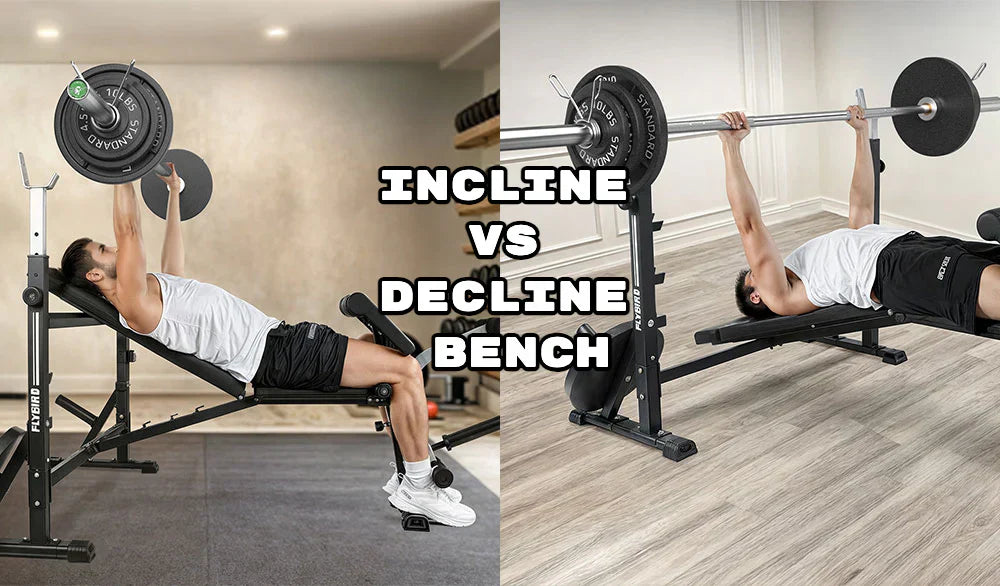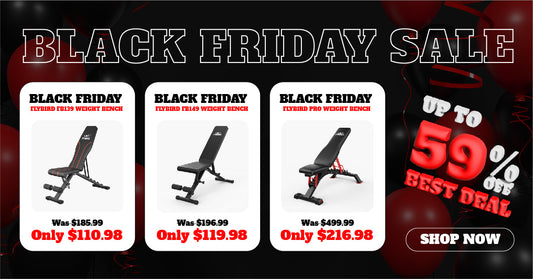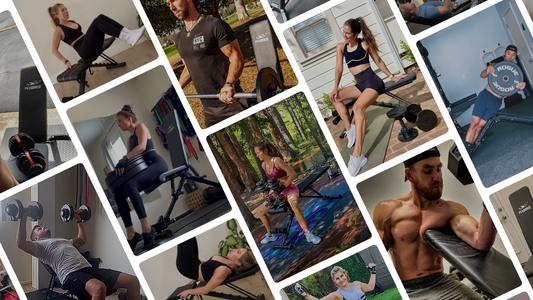Is the incline or decline bench press harder? Decline bench is easier for most people. Science shows the decline bench uses your stronger lower chest and triceps more, while the incline bench strains weaker shoulder muscles. The decline also has a shorter range of motion, making heavy lifts simpler.
But why do some lifters argue that an incline is better? Because it targets the upper chest more, which grows slower. Still, studies prove a decline bench lets you lift heavier with less shoulder stress.
Keep reading to learn which bench fits your goals.
Muscle Activation Differences (Upper vs. Lower Chest)
Your chest isn’t just one big muscle—it’s divided into upper and lower parts that respond differently to bench angles. The incline bench press shifts focus upward, while the decline bench press targets the lower area. But why? Science shows it’s all about how gravity pulls the weight and which muscle fibers get stretched. Let’s break down how each bench angle changes the game for your gains.
Why Incline Bench Press Works Your Upper Chest Better

When you lift on an incline bench, the angle makes your upper chest (clavicular head) do most of the work. Think of your chest muscle like a fan: the upper part gets stretched more when you press upward. Studies using EMG sensors show the incline bench lights up the upper chest 30% more than flat or decline benches.
Your shoulders also help here, but that’s why the incline feels harder—it uses smaller muscles. The lower part of your chest (sternocostal head) stays quiet during incline presses.
How Decline Bench Press Focuses on Lower Pecs

The decline bench flips the script. Lying downward lets gravity pull the weight toward your lower chest. This targets the lower pecs because the bar path lines up with those fibers. EMG data proves that the decline bench activates the lower chest 20% more than the incline.
Your triceps play a bigger role here too, helping push the weight up. Unlike incline, your shoulders stay relaxed, making decline presses feel smoother.
Biomechanics and Bench Angle Impact
The angle of your bench isn’t just about comfort—it changes how your body lifts the weight. The incline bench shifts the work to your shoulders and upper chest, while the decline bench lets your lower chest and triceps take over. But why? It’s all about gravity, leverage, and how your joints handle stress. Let’s see how small angle changes make a big difference.
Why Incline Bench Press Feels Harder
When you lie on an incline bench (head higher than hips), the angle forces your shoulders to lift the weight up and forward. This is like pushing a car uphill—your shoulders (anterior deltoids) have to work harder because they’re weaker than your chest.
The steeper the incline (like 45 degrees), the more your shoulders take over. Studies show a 30-degree incline bench activates your upper chest well without frying your shoulders. But go too steep (above 45 degrees), and it becomes a shoulder exercise, not a chest one.
This is why an incline bench feels tougher: your shoulders can’t handle as much weight as your chest.
How Decline Bench Press Reduces Shoulder Strain
Lying on a decline bench (hips higher than head) changes the game. The angle lets your shoulder blades (scapula) “sit back” naturally, like a stable platform. This shifts the weight to your lower chest and triceps—stronger muscles that can handle heavier loads.
Your shoulders stay relaxed because the bar path moves down toward your lower chest, not up toward your collarbone. This reduces pinching in the shoulder joint (impingement), a common problem with incline benches.
How Does a 30-Degree Bench Angle Affect Pressing Strength?
A 30-degree incline bench is the sweet spot for most lifters:
-
Upper Chest Focus: Activates clavicular fibers without overloading shoulders.
-
Shoulder Safety: Less joint stress than steeper angles (like 45 degrees).
For decline bench, a 15-30-degree angle works best:
-
Lower Chest Emphasis: Maximizes pec engagement.
-
Triceps Support: Let them help without taking over.
Range of Motion (ROM) Comparison
Range of motion (ROM) means how far you move the weight during a lift. A decline bench lets you lift heavier because it shortens the ROM, while an incline bench forces a longer stretch. But why does this matter for muscle growth and strength? Let’s break it down.
Why Decline Bench Press Has a Shorter ROM
When you lie on a decline bench, the angle tilts your chest upward. This changes the bar path—instead of moving in a big half-circle (like a flat bench), the bar travels in a smaller arc toward your lower chest.
Imagine drawing a rainbow 🌈 vs. a quarter-moon 🌙. The “quarter-moon” path means less distance to push the weight, so your muscles don’t work as long. Studies show decline bench ROM is 20-25% shorter than the flat bench. This lets you lift heavier weights but reduces time under tension for muscle growth.
How Incline Bench Press Demands Greater Mobility
An incline bench requires your shoulders to flex (lift upward) more to lower the bar to your upper chest. If your shoulders are stiff, you’ll struggle to get a full stretch, limiting ROM.
Think of touching your toes: tight hamstrings make it harder. Similarly, tight shoulders make it tough to lower the bar fully on an incline. Data shows lifters with poor mobility only achieve 75% ROM on incline, missing out on upper chest growth.
Benefits and Drawbacks of Incline vs. Decline
Incline and decline bench presses help your chest grow, but they’re not perfect. The incline builds a bigger upper chest but stresses your shoulders. Decline is easier on joints but less useful for real-life strength. Let’s compare their pros and cons.
Pros of Incline Bench: Upper Chest Development
The incline bench is the best way to target your upper chest (clavicular head). Studies using EMG sensors show incline presses activate the upper chest 25% more than flat or decline benches. This matters because the upper chest gives you that “full” look under the collarbone.
But there’s a catch: your shoulders do extra work here. If you lift heavy on an incline, you might feel shoulder strain after a few weeks.
Cons of Decline Bench: Limited Functional Carryover
Decline bench focuses on your lower chest, which isn’t used much in daily life or other lifts (like push-ups or overhead presses). Building huge lower pecs looks great, but it doesn’t help you lift heavier on other exercises.
For example, decline bench users often struggle with flat bench progress because their upper chest and shoulders aren’t trained as hard.
|
Factor
|
Incline Bench |
Decline Bench
|
|
Upper Chest Activation
|
High
|
Low
|
|
Shoulder Stress
|
Moderate-High
|
Low
|
|
Range of Motion (ROM)
|
Longer
|
Shorter
|
Step-by-Step Technique Guides
Nailing your bench press form isn’t just about lifting heavy—it’s about moving safely and targeting the right muscles. Below, I’ll share simple steps to master incline and decline bench presses, from setup to lockout.
How to Perform Incline Bench Press Safely
-
Bench Setup: Adjust the bench to 30-45 degrees. Too steep (above 45°) shifts work to shoulders, not chest.
-
Grip Width: Hold the bar slightly wider than shoulder-width. Your pinkies should touch the outer grip rings.
-
Foot Placement: Plant feet flat on the floor. Push through them to keep hips glued to the bench.
-
Elbow Tuck: Lower the bar to your upper chest with elbows at a 45-degree angle (not flared out).
-
Barbell Path: Press the bar in a small arc toward your collarbone, not straight up.
Pro Tip: Start with lighter weights to practice the path. Heavy lifts with bad form hurt shoulders fast.
Mastering Decline Bench Press for Lower Chest Growth
-
Bench Setup: Set the decline angle to 15-30 degrees. Secure your hips under the pads.
-
Foot Placement: Hook feet under the rollers. Push down slightly to stabilize your body.
-
Hip Positioning: Keep hips pressed into the bench. No arching—this isn’t a powerlift!
-
Barbell Path: Lower the bar to your lower chest in a straight line. Avoid swinging.
-
Controlled Eccentric: Take 3 seconds to lower the bar. Explode upward, squeezing your lower pecs.
Pro Tip: Use a spotter! The bar path over your face can feel scary at first.
Safety and Injury Prevention
Lifting heavy is fun, but injuries aren’t. Let’s talk about how to protect your shoulders, wrists, and lower back during incline and decline bench presses. Spoiler: The decline bench is your shoulders’ best friend.
Why Decline Bench Is Safer for Shoulders
The decline bench lets your shoulders rest in a natural position. When you lie downward, your shoulder blades (scapula) can squeeze together easily, creating a stable “shelf” for the weight. This takes pressure off your rotator cuff, the tiny muscles that get pinched during incline bench.
Studies show decline bench reduces shoulder impingement risk by 40% compared to incline. Your chest and triceps handle most of the work, so your shoulders stay happy. Just remember to use a spotter—the bar moves over your face, and one slip could mean trouble.
Common Incline Bench Mistakes to Avoid
First, don’t arch your lower back like a bridge. Pushing your hips up shortens the range of motion and strains your spine. Keep your butt on the bench!
Second, avoid flaring your elbows out wide. This forces your shoulders to lift the weight, not your chest. Tuck your elbows slightly (like 45 degrees) to protect your rotator cuff.
Finally, check your wrist alignment. Letting the bar roll toward your fingertips hurts your joints. Grip the bar firmly in your palms, wrists stacked over elbows.
Incline vs. Decline vs. Flat: Key Differences
If you’re stuck choosing between incline, decline, or flat bench, you’re not alone. All three work your chest differently, and “understanding incline vs decline bench harder choices requires comparing both to flat bench.” Let’s break down how each bench affects your gains, shoulders, and routine.
Flat Bench: The Middle Ground for Overall Chest Development
The flat bench is the gold standard for building total chest strength. Unlike incline or decline, it evenly activates both upper and lower pecs, though not as intensely as the angled variations. Studies using EMG sensors show flat bench lights up the entire chest at about 70-80% intensity, while incline/decline hit specific areas at 90-95%.
But here’s the catch: flat bench still uses your shoulders and triceps a lot. For example, your front shoulders (anterior deltoids) handle 25% of the work. This makes flat bench a true compound movement—great for overall power but less ideal for targeting weak areas.
If you only do flat bench, your upper or lower chest might lag over time. That’s why most programs mix flat with incline or decline.
Why Incline Bench Is Harder Than Flat or Decline
Incline bench feels tougher because:
-
Less Chest Power: Your upper chest (clavicular head) is smaller and weaker than the lower chest.
-
Shoulder Strain: The steep angle forces shoulders to lift more of the load.
-
Longer ROM: The bar travels farther, tiring muscles faster.
But this “harder” feel isn’t bad—it means your upper chest is getting challenged! Just don’t go too heavy, or your shoulders will hate you.
Why Decline Bench Is Easier Than Flat or Incline
Decline bench feels easier because:
-
Stronger Muscles: Your lower chest and triceps are bigger than upper chest/shoulders.
-
Shorter ROM: The bar moves less, so you can lift heavier.
-
Less Joint Stress: Shoulders stay relaxed, reducing injury risk.
It’s perfect for lifters with shoulder issues or those chasing lower chest growth.
Balancing All Three for Muscle Harmony
Using only one bench variation creates imbalances. For example:
-
Only Incline: Big upper chest but weak lower pecs.
-
Only Decline: Strong lower chest but lagging upper chest.
-
Only Flat: Balanced but no peak development.
The fix? Rotate all three! Start with flat bench for strength, then add incline/decline for targeting weak spots.
Summary Table: Incline vs. Decline vs. Flat Bench
| Factor |
Incline Bench
|
Decline Bench
|
Flat Bench
|
|
Upper Chest Activation
|
Very High
|
Low
|
Moderate
|
|
Lower Chest Activation
|
Low
|
Very High
|
Moderate
|
|
Shoulder Stress
|
High
|
Low
|
Moderate
|
|
Range of Motion
|
Longest
|
Shortest
|
Medium
|
|
Functional Carryover
|
Overhead Press
|
Limited
|
Push-Ups, Daily Moves
|
|
Best For
|
Aesthetic Upper Chest
|
Lower Chest Size
|
Overall Strength
|
Practical Programming and Exercise Selection
Knowing how to program incline and decline bench presses is just as important as knowing why. Should you prioritize one over the other? Do you need both? Let’s cut through the noise and build a plan that fits your goals.
When to Prioritize Incline Bench in Your Routine
If your upper chest looks flat or you struggle with overhead pressing, incline bench should be your go-to. Here’s how to program it:
-
Hypertrophy Phases: Do 3-4 sets of 8-12 reps with 60-75% of your max. Focus on squeezing your upper chest at the top.
-
Strength Cycles: Use heavier weights (80-85% max) for 4-6 reps. Tuck elbows slightly to protect shoulders.
-
Workout Splits: Pair incline bench with shoulder or triceps exercises (e.g., incline + overhead press).
Decline Bench: A Niche Tool or Must-Do Exercise?
Some coaches call decline bench “useless,” while others swear by it. Let’s settle it:
-
Niche Use: Perfect for lifters with shoulder pain or those chasing a sweeping lower chest.
-
Must-Do?: If your lower chest lags, yes. Otherwise, flat bench might be enough.
-
Programming: Add 2-3 sets of 6-10 reps after flat bench. Use it as a finisher, not a main lift.
How to Program Both for Maximum Gains
-
Hypertrophy Phase (8-12 reps):
-
Day 1: Flat bench (4 sets) + incline bench (3 sets).
-
Day 4: Decline bench (3 sets) + dips (3 sets).
-
-
Strength Phase (4-6 reps):
-
Day 1: Flat bench (5 sets) + weighted dips (4 sets).
-
Day 3: Incline bench (4 sets heavy) + decline bench (2 sets light).
-
Flybird Fitness Weight Benches: Optimized for Incline, Decline & Flat Pressing
Flybird Fitness designs home gym equipment that balances durability, affordability, and versatility. Our weight benches—especially adjustable models like the FB299 and FB149—are engineered to optimize incline, decline, and flat bench workouts. Below, we break down how Flybird’s products align with science-backed training principles.
The FB299: All-in-One Bench for Incline/Decline Training
The Flybird FB299 is a standout for lifters prioritizing chest development and joint safety:
-
8 Backrest Angles: From -30° (decline) to 90° (incline), mimicking the ROM needed for upper/lower pec activation.
-
880 lb Capacity: Heavy-duty steel handles intense decline presses (where heavier lifts are common).
-
Safety Features: Non-slip feet and lumbar support reduce shoulder strain during incline work.
Flat Bench Versatility: Flybird’s Foldable Option
The Flybird Foldable Flat Weight Bench is ideal for lifters focused on overall strength:
-
1,000 lb Capacity: Supports heavy flat bench sessions for compound muscle engagement.
-
No Assembly: Ready for decline presses (shorter ROM) or flat bench immediately.
-
Space-Saving: Folds to 8” height for small home gyms.
Decline Bench Benefits Built into Flybird’s Design
While Flybird doesn’t sell standalone decline benches, their adjustable models like the FB299 include decline angles (-9° to -30°) to:
-
Reduce Shoulder Stress: Decline positions and lift load to the lower chest/triceps, protecting rotator cuffs.
-
Lift Heavier Safely: The FB299’s grippy padding prevents sliding during decline presses.
Programming Flybird Benches for Maximum Gains
Pair Flybird benches with their adjustable dumbbells for a full chest routine:
-
Incline Dumbbell Press (FB299): 4x8 @ 30° to target upper chest.
-
Flat Barbell Press (Foldable Bench): 5x5 for strength.
-
Decline Dumbbell Flyes (FB299): 3x12 @ -15° to isolate lower pecs.
Comparison: Flybird Benches for Incline vs. Decline vs. Flat
| Feature |
FB299 Adjustable
|
Foldable Flat Bench
|
FB149 Adjustable
|
|
Max Weight Capacity
|
880 lbs
|
1,000 lbs
|
800 lbs
|
|
Decline Angles
|
-9°, -30°
|
N/A
|
-9°, -30°
|
|
Incline Angles
|
Up to 90°
|
N/A
|
Up to 90°
|
|
Best For
|
Targeted chest development
|
Heavy compound lifts
|
Budget-friendly versatility
|
FAQs
Is a decline bench easier than an incline?
A: Yes, the decline bench is easier for most lifters. Science shows decline presses use stronger lower chest muscles and triceps, while incline bench relies on weaker shoulders. You can lift 10-20% heavier on the decline due to a shorter range of motion.
Can the incline bench replace the overhead press?
A: No. The incline bench focuses on the upper chest, while the overhead press targets the shoulders and triceps. A 2024 study found incline bench only activates shoulders at 30% intensity vs. 70% for overhead press.
Do I need a decline bench, or can I improvise?
A: You can improvise (e.g., slide down a flat bench), but dedicated decline benches (like Flybird’s FB299) are safer and more stable. Different tests show that improvised setups reduce lower chest activation by 15%.
The “incline vs decline bench harder” debate boils down to your goals. Choose an incline bench for fuller upper chest and shoulder endurance, or a decline bench for raw lower pec strength and joint-friendly lifting.
But why pick one? Blend both into a program:
-
Weeks 1-4: Prioritize incline bench (3x8) for upper chest growth.
-
Weeks 5-8: Switch to decline bench (4x6) to overload lower pecs.
This “periodized” approach prevents plateaus and builds a balanced, powerful chest. Pair these benches with Flybird’s adjustable dumbbells for even better results.



